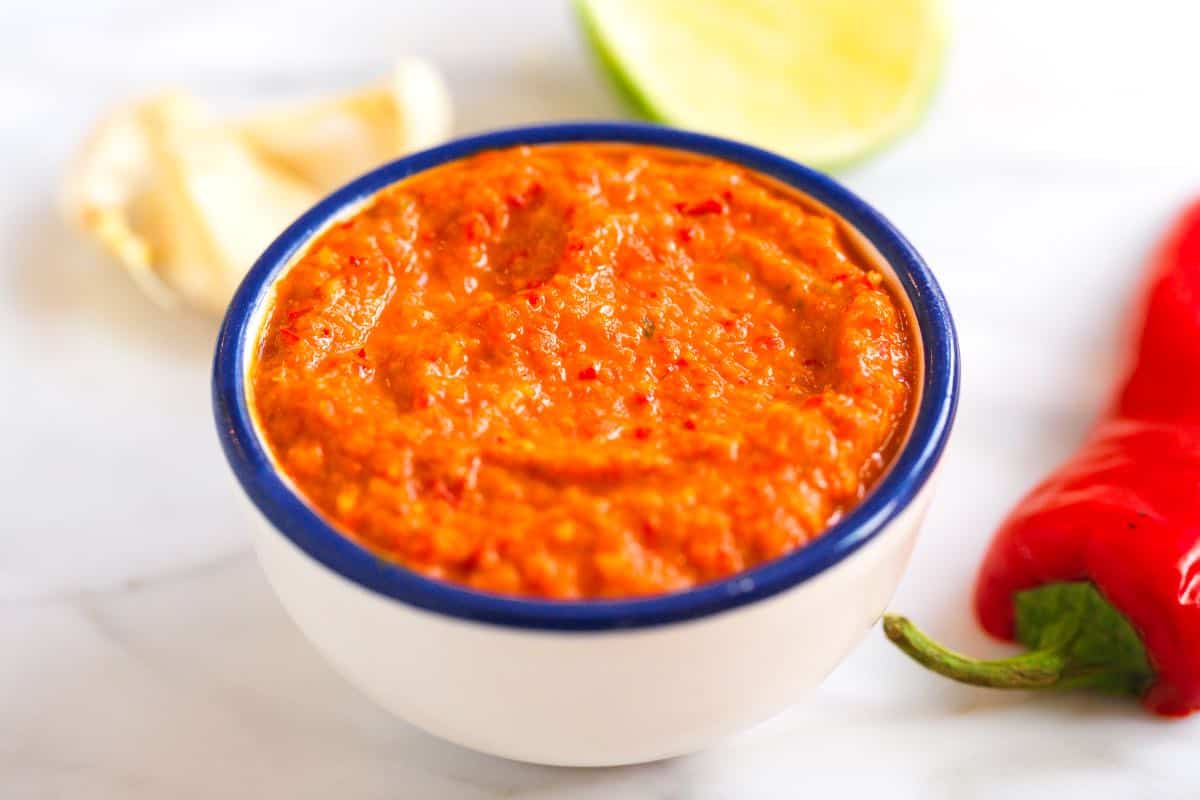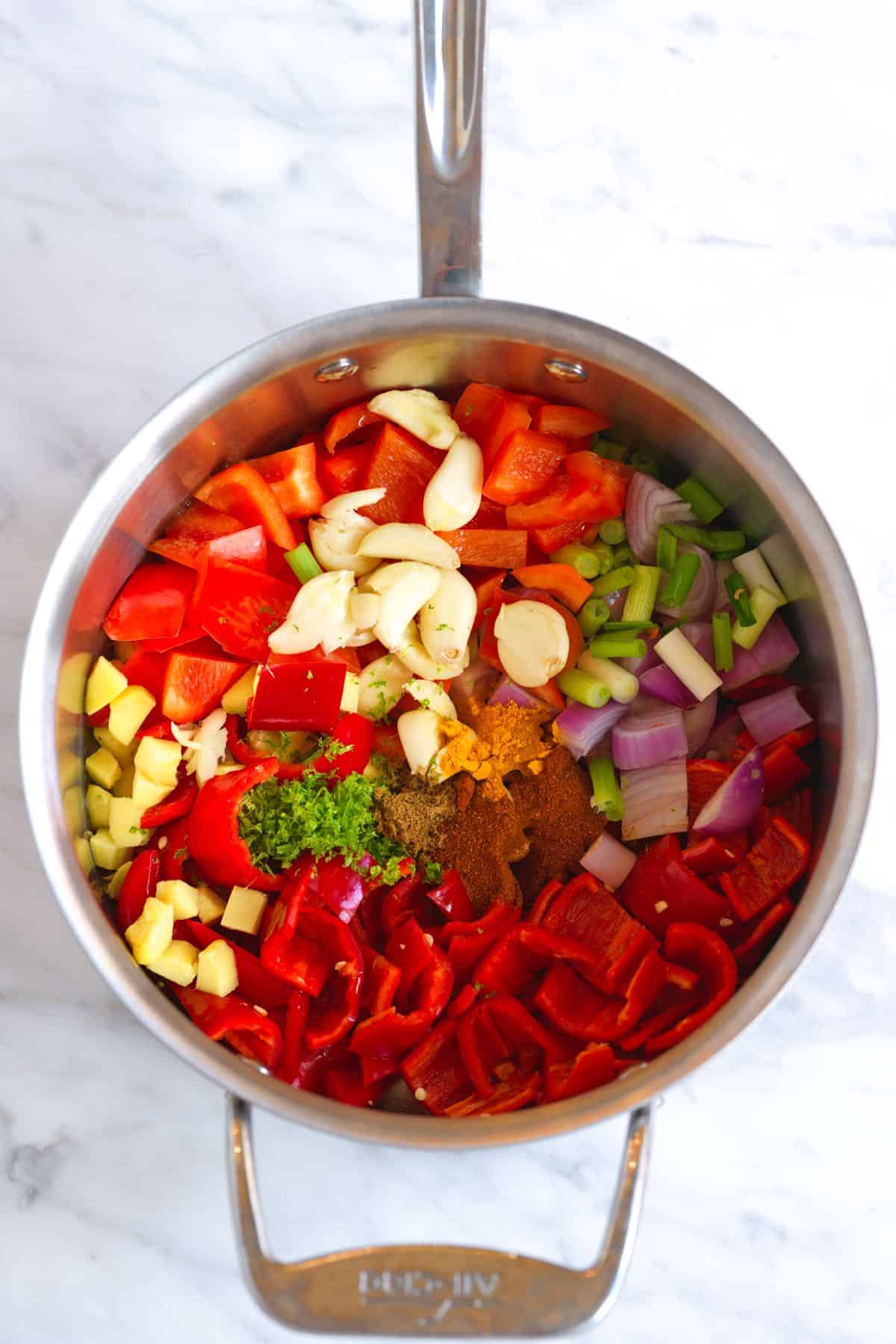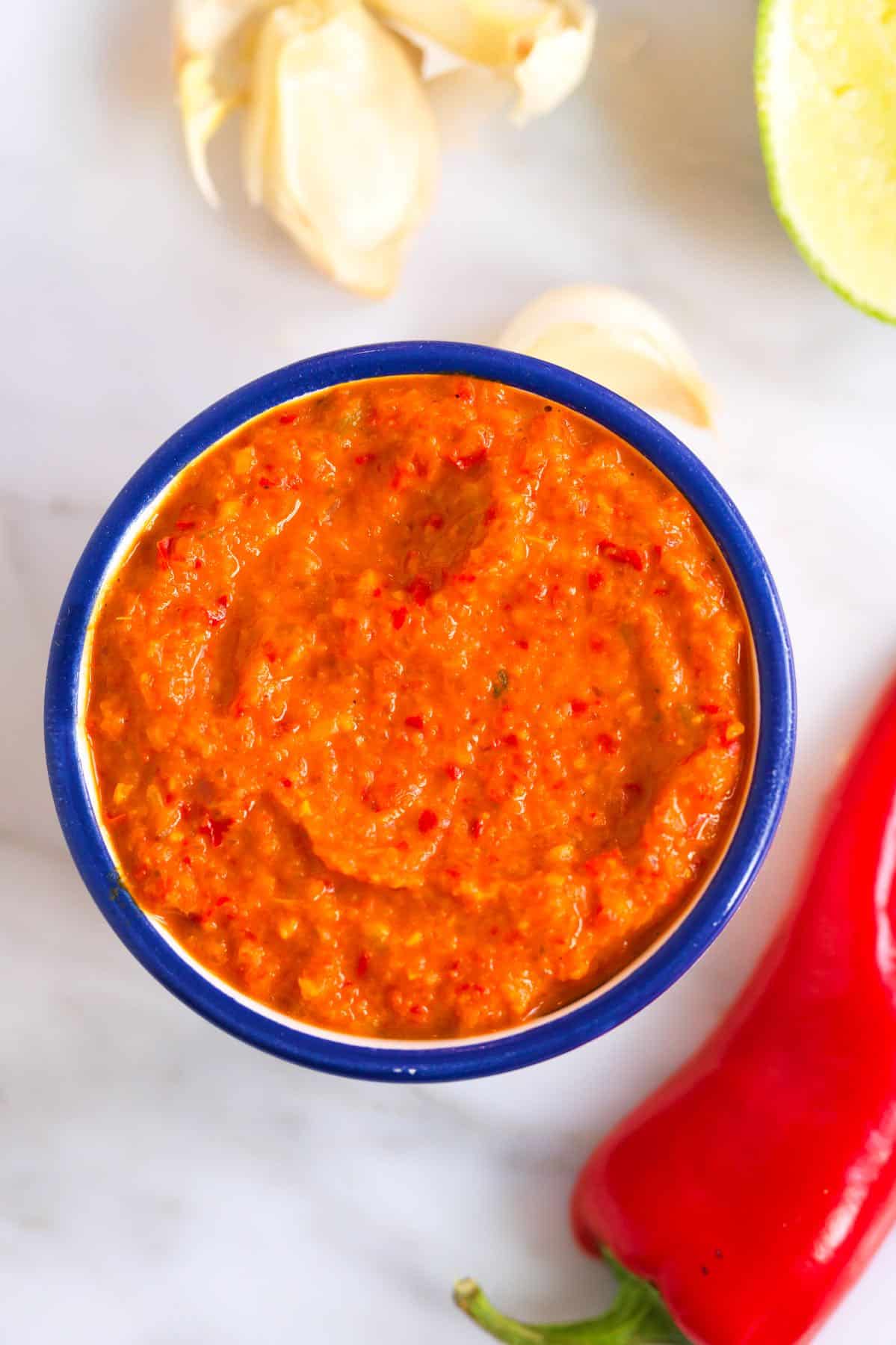I can’t stop making this homemade red curry paste! Our recipe uses easy-to-find ingredients and is incredibly flavorful! It’s amazing for Thai curries (of course!), but I’ve shared many more uses below!

This recipe for homemade red curry paste is near and dear to my heart. It’s made with fresh ingredients like chiles, ginger, and lemongrass. It’s super flavorful and absolutely perfect for making curries, like our vegetable red curry. But don’t stop there! Use it to marinate chicken, add a kick to stir-fries, add to noodles, and more!
We love this Thai red curry paste so much that it inspired us to create homemade yellow curry paste and green curry paste recipes (coming soon)! In the meantime, pair dishes made with this red curry paste with our coconut rice and crispy fried garlic for an incredible Thai-inspired meal!
Key Ingredients
- Peppers: I know what you might be thinking: “Shouldn’t this have Thai chilies?” And you’re right! Authentic Thai red curry paste often uses them. But, they can be hard to find, and they are firey. So, to make this recipe more accessible, we’re using Fresno chilies (or similar) and red bell pepper. It’s still got plenty of spice! We just wanted to make sure you could find the ingredients. That said, if you can find Thai chilies, I’ve included extra notes below the recipe for using them!
- Shallots, Green Onions, and Garlic: These aromatics form the foundation of our curry paste, guaranteeing an absolutely irresistible flavor.
- Ginger, Turmeric, and Lemongrass: Fresh ginger is a must-have and, fortunately, widely available. Fresh turmeric is amazing, too, but if you can’t find it, I’ve shared tips for using dried turmeric in the recipe (which, honestly, I use all the time!). And, of course, no Thai curry paste is complete without lemongrass! I love the convenience of lemongrass paste (sold in the tubes), but if you’re working with fresh, check out the tips below the recipe.
- Paprika and Cumin: We use sweet paprika (not smoked), which adds color and richness. The cumin also makes a big difference (although we only need a tiny bit!).
- Lime, Fish Sauce, and Tamari: These three bring everything together, adding brightness, umami, and a touch of saltiness. While some authentic pastes use dried shrimp or shrimp paste, fish sauce is a great alternative that’s much easier to find (if vegetarian, omit the fish sauce). And if you don’t have tamari, regular soy sauce works perfectly fine!
How to Make Red Curry Paste
Once you have the ingredients, making homemade curry paste is super simple. Toss the chiles, red bell pepper, shallots, green onions, garlic cloves, ginger, turmeric, paprika, cumin, and lime zest in a medium pot with a bit of oil. Cook them until they just start to soften, and then turn off the heat, cover them with a lid, and let them steam for a few minutes.

From there, you’ll add the hot mixture to a food processor with the remaining ingredients (lime juice, fish sauce, lemongrass paste, tamari, and salt) and pulse until you reach your desired consistency. I like it pretty smooth with some grittiness to see the specks of red chiles.
Ways to Use Red Curry Paste
The most well-known way to use red curry paste is to make a classic red curry (like this veggie curry), but we use it in our kitchen in many other ways. We use red curry in marinades, stir-fries, soups, noodles, and dipping sauces and add it to mayonnaise for a flavored mayo. You can even mix it into ground meat like beef or chicken and make Thai spiced meatballs.
When working with red curry paste, start small. It’s pretty potent, so I like to begin with a small amount and add more to taste (for this homemade paste, start with 1 tablespoon and go from there for things like curries or use less if you are sensitive to spice).
I love frying curry paste in a bit of oil to “bloom” the flavors. It makes a big difference with flavor! And don’t forget that curry paste is intentionally bold, spicy, and seasoned, so keep other ingredients on hand to help balance it, like lime juice, fish sauce, sugar, and something creamy like coconut milk or yogurt.

Homemade Red Curry Paste
-
PREP
-
COOK
-
TOTAL
I can’t stop making this Thai red curry paste! It is potent, so when using it in dishes, start with a small amount and add more to taste. This way, you can adjust the spiciness and flavor to your preference. Creamy ingredients (like coconut milk or yogurt) will tone down the spice level.
*I highly recommend wearing food-safe gloves when prepping the chile peppers to protect your skin from the oils.
Makes 2 cups
You Will Need
1 ½ tablespoons avocado oil
9 whole Fresno red chilies, seeded and chopped
1 red bell pepper, seeded and chopped
2 shallots, peeled and chopped
2 green onions, chopped
12 garlic cloves, smashed and peeled
3 ½ tablespoons chopped fresh ginger (3 to 4-inch piece)
1 tablespoon chopped fresh turmeric or 1 teaspoon dried turmeric
1 ½ teaspoon paprika
1/4 teaspoon ground cumin
1 lime, zested and juiced
1 ½ teaspoons fish sauce
1 teaspoon lemongrass paste, see tips
1/2 teaspoon tamari or soy sauce
1 teaspoon salt
Directions
1Combine the avocado oil, chiles, red bell pepper, shallots, green onions, garlic cloves, ginger, turmeric, paprika, cumin, and lime zest in a medium pot.
2Place over medium-high heat and cook, stirring often, until fragrant and slightly softened, about 5 minutes. You are not looking to add much color, but some blistering is okay.
3Once somewhat tender and starting to blister, turn off the heat and place a lid on the pot so everything steams for 5 minutes.
4Spoon the hot ingredients into a food processor and then pulse to create a rough paste.
5Add lime juice, fish sauce, lemongrass paste, tamari, and salt. Blend until smoother but still slightly gritty.
Adam and Joanne’s Tips
- For curries: Start with 1 to 2 tablespoons of curry paste per cup of coconut milk. You can always add more later!
- For marinades/other dishes: Begin with 1 tablespoon of curry paste per pound of meat.
- Using Thai red chiles: As noted in the article, we use Fresno chiles (or similar) instead of Thai chilies because they are more widely available and a bit less hot than authentic Thai chilies. If you have Thai chilies, feel free to use them. We recommend seeding them. You will need 2 to 3 Thai chilies for every Fresno chile in our recipe above. Remember, using Thai chilies will make this paste significantly more spicy.
- Lemongrass paste: I buy the refrigerated lemongrass paste in a squeezable tube sold near the fresh herbs.
- Using fresh lemongrass: Cut away the top and bottom of the stalk. Then, peel away the tough outer layers until you reach the tender, pale yellow core. Finally, thinly slice the stalk, then chop it as finely as possible or use a food processor to mince it. When using fresh lemongrass in this recipe, you’ll need 1 teaspoon minced. Then, add the minced lemongrass to the saucepan along with the ginger, garlic, and shallots (slightly different than when using the premade paste). If you make a larger batch of homemade lemongrass paste, store in an airtight container in the fridge for a few days or freeze in ice cube trays, transfer to freezer bags, and freeze for up to 3 months.
- Vegetarian/vegan adaptations: Ensure all ingredients are vegan/vegetarian, and omit the fish sauce.
- Storing in the fridge: Allow the curry paste to cool, add it to a clean glass jar, add a thin layer of avocado oil on top, and then store it in the fridge for up to 1 week, possibly longer.
- Storing in the freezer: You can freeze this for up to 3 months. Portion the paste into small freezer-safe containers or ice cube trays. If using ice cube trays, freeze until frozen, pop them out, and store them in a freezer-safe airtight container.
- Nutrition facts are estimates.
Nutrition Per Serving
Serving Size
2 tablespoons
/
Calories
35
/
Total Fat
1.5g
/
Saturated Fat
0.2g
/
Cholesterol
0mg
/
Sodium
206.8mg
/
Carbohydrate
4.9g
/
Dietary Fiber
0.9g
/
Total Sugars
2.1g
/
Protein
0.9g
